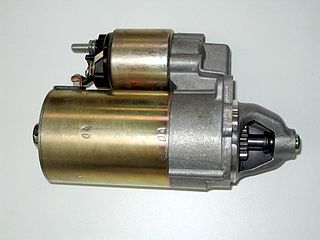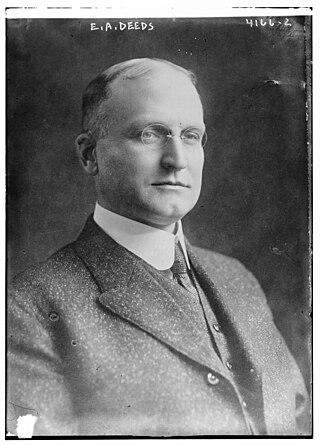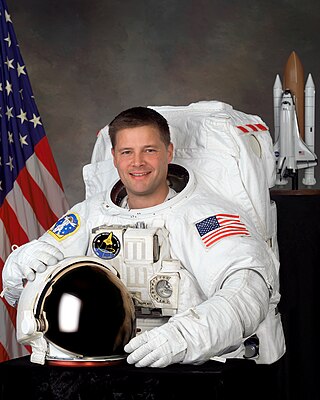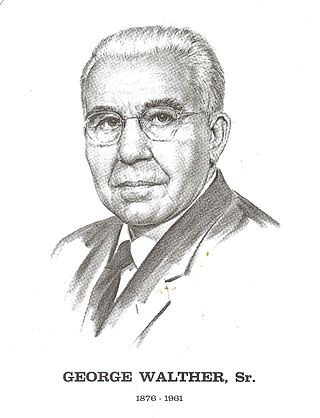
A starter is a device used to rotate (crank) an internal-combustion engine so as to initiate the engine's operation under its own power. Starters can be electric, pneumatic, or hydraulic. The starter can also be another internal-combustion engine in the case, for instance, of very large engines, or diesel engines in agricultural or excavation applications.

Charles Franklin Kettering sometimes known as Charles Fredrick Kettering was an American inventor, engineer, businessman, and the holder of 186 patents. He was a founder of Delco, and was head of research at General Motors from 1920 to 1947. Among his most widely used automotive developments were the electrical starting motor and leaded gasoline. In association with the DuPont Chemical Company, he was also responsible for the invention of Freon refrigerant for refrigeration and air conditioning systems. At DuPont he also was responsible for the development of Duco lacquers and enamels, the first practical colored paints for mass-produced automobiles. While working with the Dayton-Wright Company he developed the "Bug" aerial torpedo, considered the world's first aerial missile. He led the advancement of practical, lightweight two-stroke diesel engines, revolutionizing the locomotive and heavy equipment industries. In 1927, he founded the Kettering Foundation, a non-partisan research foundation, and was featured on the cover of Time magazine in January 1933.

The Apollo spacecraft was composed of three parts designed to accomplish the American Apollo program's goal of landing astronauts on the Moon by the end of the 1960s and returning them safely to Earth. The expendable (single-use) spacecraft consisted of a combined command and service module (CSM) and an Apollo Lunar Module (LM). Two additional components complemented the spacecraft stack for space vehicle assembly: a spacecraft–LM adapter (SLA) designed to shield the LM from the aerodynamic stress of launch and to connect the CSM to the Saturn launch vehicle and a launch escape system (LES) to carry the crew in the command module safely away from the launch vehicle in the event of a launch emergency.

Nancy Jane Currie-Gregg is an American engineer, United States Army officer and a NASA astronaut. Currie-Gregg has served in the United States Army for over 22 years and holds the rank of colonel. With NASA, she has participated in four space shuttle missions: STS-57, STS-70, STS-88, and STS-109, accruing 1,000 hours in space. She currently holds an appointment as a professor of practice in the Department of Industrial & Systems Engineering at Texas A&M University.

A brushless DC electric motor (BLDC), also known as an electronically commutated motor, is a synchronous motor using a direct current (DC) electric power supply. It uses an electronic controller to switch DC currents to the motor windings producing magnetic fields which effectively rotate in space and which the permanent magnet rotor follows. The controller adjusts the phase and amplitude of the DC current pulses to control the speed and torque of the motor. This control system is an alternative to the mechanical commutator (brushes) used in many conventional electric motors.

The Apollo command and service module (CSM) was one of two principal components of the United States Apollo spacecraft, used for the Apollo program, which landed astronauts on the Moon between 1969 and 1972. The CSM functioned as a mother ship, which carried a crew of three astronauts and the second Apollo spacecraft, the Apollo Lunar Module, to lunar orbit, and brought the astronauts back to Earth. It consisted of two parts: the conical command module, a cabin that housed the crew and carried equipment needed for atmospheric reentry and splashdown; and the cylindrical service module which provided propulsion, electrical power and storage for various consumables required during a mission. An umbilical connection transferred power and consumables between the two modules. Just before reentry of the command module on the return home, the umbilical connection was severed and the service module was cast off and allowed to burn up in the atmosphere.

Thomas Joseph Kelly was an American aerospace engineer. Kelly primarily worked on the Apollo Lunar Module, which earned him the name of "Father of the Lunar Module" from NASA.

Project Gemini was NASA's second human spaceflight program. Conducted between projects Mercury and Apollo, Gemini started in 1961 and concluded in 1966. The Gemini spacecraft carried a two-astronaut crew. Ten Gemini crews and 16 individual astronauts flew low Earth orbit (LEO) missions during 1965 and 1966.
Johnson Electric (德昌電機控股有限公司) is a provider of motors, actuators, motion subsystems and related electro-mechanical components for automotive, industrial and medical applications. Johnson Electric has manufacturing facilities in 22 countries.

A pneumatic motor, or compressed air engine, is a type of motor which does mechanical work by expanding compressed air. Pneumatic motors generally convert the compressed air energy to mechanical work through either linear or rotary motion. Linear motion can come from either a diaphragm or piston actuator, while rotary motion is supplied by either a vane type air motor, piston air motor, air turbine or gear type motor.

A mixer, depending on the type, also called a hand mixer or stand mixer, is a kitchen device that uses a gear-driven mechanism to rotate a set of "beaters" in a bowl containing the food or liquids to be prepared by mixing them.

Edward Andrew Deeds was an American engineer, inventor and industrialist prominent in the Dayton, Ohio, area. He was the president of the National Cash Register Company and, together with Charles F. Kettering, founded Dayton Engineering Laboratories Company (Delco), an early innovator in automotive technology. Deeds partnered with the Orville Wright in an early airplane manufacturing venture and led the military aircraft production effort in World War I.

Douglas Harry "Wheels" Wheelock is an American engineer and astronaut. He has flown in space twice, logging 178 days on the Space Shuttle, International Space Station, and Russian Soyuz. On July 12, 2011, Wheelock announced that he would be returning to active duty with the United States Army in support of Operation Enduring Freedom. He is currently working with NASA to test the Orion spacecraft at the Glenn Research Center in Plum Brook, Ohio.
Delco Electronics Corporation was the automotive electronics design and manufacturing subsidiary of General Motors based in Kokomo, Indiana, that manufactured Delco Automobile radios and other electric products found in GM cars. In 1972, General Motors merged it with the AC Electronics division and it continued to operate as part of the Delco Electronics division of General Motors. When the corporation acquired the Hughes Aircraft Company, Delco was merged with it to form Hughes Electronics as an independent subsidiary.
Denison Hydraulics is a publicly traded U.S.-based company that manufactures industrial hydraulic fluid power systems and components and is headquartered in Marysville, Ohio. Denison is owned by Parker Hannifin. Denison has annual revenues of about $180 million, has 1,150 employees in North America, Europe and Asia, and approximately 61 percent of its customer base is in Europe.

Globus IMP instruments were spacecraft navigation instruments used in Soviet and Russian crewed spacecraft. The IMP acronym stems from the Russian expression Indicator of position in flight, but the instrument is informally referred to as the Globus. It displays the nadir of the spacecraft on a rotating terrestrial globe. It functions as an onboard, autonomous indicator of the spacecraft's location relative to Earth coordinates. An electro-mechanical device in the tradition of complex post-World War II clocks such as master clocks, the Globus IMP instrument incorporates hundreds of mechanical components common to horology. This instrument is a mechanical computer for navigation akin to the Norden bombsight. It mechanically computes complex functions and displays its output through mechanical displacements of the globe and other indicator components. It also modulates electric signals from other instruments.

George Walther Sr. was an American inventor, engineer, businessman, civic leader and the holder of over 100 patents for truck wheels, brake drums, fifth wheels, and landing gear/legs for the trucking industry. He was the founder of the Dayton Steel Foundry.

Arthur William Haydon was an American inventor known for his work in the field of microminiature electrical timing and governing devices for industrial and military use, some of which were to be used in early computing devices.
In engineering, a solenoid is a device that converts electrical energy to mechanical energy, using an electromagnet formed from a coil of wire. The device creates a magnetic field from electric current, and uses the magnetic field to create linear motion. In electromagnetic technology, a solenoid is an actuator assembly with a sliding ferromagnetic plunger inside the coil. Without power, the plunger extends for part of its length outside the coil; applying power pulls the plunger into the coil. Electromagnets with fixed cores are not considered solenoids. In simple terms, a solenoid converts electrical energy into mechanical work. Typically, it has a multiturn coil of magnet wire surrounded by a frame, which is also a magnetic flux carrier to enhance its efficiency. In engineering, the term may also refer to a variety of transducer devices that convert energy into linear motion, more sophisticated than simple two–position actuators. The term "solenoid" also often refers to a solenoid valve, an integrated device containing an electromechanical solenoid which actuates either a pneumatic or hydraulic valve, or a solenoid switch, which is a specific type of relay that internally uses an electromechanical solenoid to operate an electrical switch; for example, an automobile starter solenoid or linear solenoid. Solenoid bolts, a type of electromechanical locking mechanism, also exist.

A motorized potentiometer combines a potentiometer with an electric motor.















